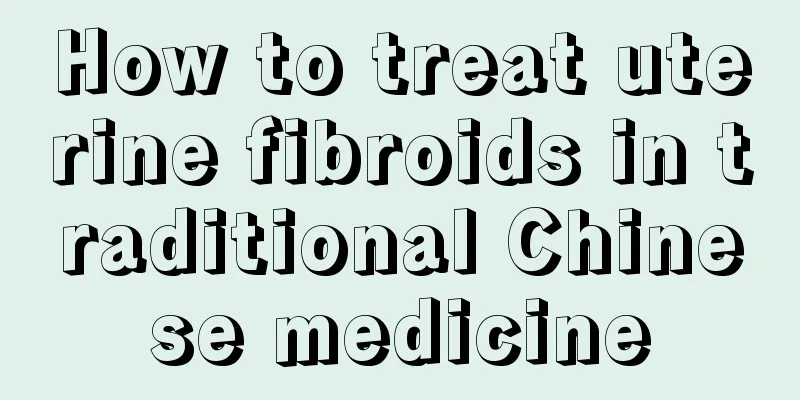How to treat uterine fibroids in traditional Chinese medicine

|
Uterine fibroids are a common gynecological disease. For patients with uterine fibroids, it may be helpful to learn about the treatment methods of uterine fibroids in traditional Chinese medicine! So how does Traditional Chinese Medicine treat uterine fibroids? Next, this article will introduce you to how to treat uterine fibroids with traditional Chinese medicine. Friends who want to know more about this knowledge can take a look! Please see the detailed introduction below. Uterine fibroids, also known as uterine leiomyoma, are the most common benign tumors of the female reproductive system. Most cases are asymptomatic, while a few may present with vaginal bleeding, abdominal masses, and compression symptoms. It may cause pain if the pedicle is twisted or other conditions occur. Multiple uterine fibroids are common. How does Traditional Chinese Medicine treat uterine fibroids? For the treatment of uterine fibroids, both drug and non-drug therapies can be used in Traditional Chinese Medicine. New diseases and qi diseases should be treated by promoting qi and activating blood circulation. Long-term diseases, blood diseases or phlegm congestion, if the condition is mild and the lump is still small, should be treated by promoting blood circulation, removing blood stasis and eliminating symptoms. If the condition is severe and the lump is large and the vital energy is gradually declining, surgical resection should be used to remove the pathogenic factors and then adjust the body. When treating uterine fibroids with traditional Chinese medicine, the main approach is dialectical classification: 1. Phlegm and dampness Main symptoms: a lump in the lower abdomen, occasional pain, tenderness when pressed, and a lot of vaginal discharge. If the patient is suffering from cold, the leucorrhea will be white and sticky, the patient will be afraid of cold, the chest and abdomen will feel stuffy and stuffy, the urination will be frequent, the tongue coating will be white and greasy, the tongue will be dark purple, and the pulse will be thin, moist and slippery. If the patient is hot, the leucorrhea will be yellow, sticky, and have a foul odor, or even pus-like. There will be chest tightness and irritability, fever and thirst, less yellow urine, a yellow and greasy tongue coating, a red tongue, and a stringy or slippery and rapid pulse. Treatment method: Regulating Qi, resolving phlegm, and eliminating symptoms. 2. Blood stasis Main symptoms: The mass in the uterus is hard and fixed, painful and resistant to pressure, accompanied by dull complexion, dry skin, heavy menstruation or delayed menstruation, dry mouth and no desire to drink. The tongue is red with petechiae on the edges, and the pulse is deep and sluggish. Treatment method: Promote blood circulation, remove blood stasis, eliminate symptoms and disperse nodules. 3. Qi stagnation Main symptoms: Distension in the lower abdomen, the mass is not firm and can be moved by pushing, and the pain may be in any place, either up or down. The tongue coating is thin, white and moist, and the pulse is deep and stringy. Treatment method: Promote Qi circulation, remove stagnation, activate blood circulation and eliminate symptoms. Traditional Chinese medicine treatment for uterine fibroids is a good treatment method, and patients can use this method for treatment under the guidance of a doctor. The above is an introduction to how to treat uterine fibroids with traditional Chinese medicine. I believe that after reading the above introduction, you will have a clearer understanding of the relevant treatment methods of uterine fibroids in traditional Chinese medicine. Therefore, for patients with uterine fibroids, you might as well try the relevant Chinese medicine treatment methods for uterine fibroids introduced above! I hope that the introduction in this article will be helpful to friends who want to understand how to treat uterine fibroids with traditional Chinese medicine. |
<<: How to treat thick endometrium
>>: How to treat endometrial translocation
Recommend
Will 34 weeks of maturity level 2 lead to premature birth?
Expectant mothers know nothing about the initial ...
How many months of pregnancy does the belly bulge
At how many months of pregnancy will the belly bu...
What bad habits cause clear vaginal discharge?
Nowadays, everyone knows that gynecological disea...
What is the best thing to eat when pregnant women have a big belly on the left side?
Many pregnant women will gradually experience var...
Abdominal pain during ovulation
Some female friends will feel a heavy pain in the...
Can eating sashimi with mustard kill insects? A must-read for seafood lovers!
Seafood is a favorite food for many people, and s...
Women who shake their buttocks when walking are happier
A woman's buttocks are an important part of h...
Can pregnant women eat chicken?
After giving birth, mothers need to breastfeed th...
How to divide the pots of Christmas cactus to make it easier for it to survive?
Christmas cactus is a common flower in life. Beca...
Can beef ribs be stewed with winter melon? How to make beef ribs delicious soup
I believe that many of you like to eat beef ribs,...
What harm does breast cyst do to the body?
Everyone knows that breast cysts are an extremely...
Can I drink beer during my period?
There are many issues that girls need to pay atte...
Why do I feel cold during confinement?
During the confinement period, mothers will have ...
Why is it itchy down there?
There are many reasons for female vulvar itching,...
What medicine should I take for menstrual bleeding?
Some female friends may encounter symptoms of pro...









